| کد مقاله | کد نشریه | سال انتشار | مقاله انگلیسی | نسخه تمام متن |
|---|---|---|---|---|
| 6854866 | 1437598 | 2018 | 48 صفحه PDF | دانلود رایگان |
عنوان انگلیسی مقاله ISI
Chaotic opposition-based grey-wolf optimization algorithm based on differential evolution and disruption operator for global optimization
ترجمه فارسی عنوان
الگوریتم بهینه سازی خاکستری و گرگ مبتنی بر مخالفت مبتنی بر اپراتور اختلاط و تداخل برای بهینه سازی جهانی است
دانلود مقاله + سفارش ترجمه
دانلود مقاله ISI انگلیسی
رایگان برای ایرانیان
موضوعات مرتبط
مهندسی و علوم پایه
مهندسی کامپیوتر
هوش مصنوعی
چکیده انگلیسی
In this paper, an improved version of the Grey Wolf Optimizer (GWO) is proposed to improve the exploration and the exploitation ability of the GWO algorithm. This improvement is performed through using the chaotic logistic map, the Opposition-Based Learning (OBL), the differential evolution(DE), and the disruption operator (DO). Where, the chaotic logistic map and the OBL are used to initialize the candidate solutions and these approaches avoid the drawbacks of the random population and increase the convergence of the algorithm. Then, the DE operators are combined with the GWO algorithm, in which, the DE operators work as a local search mechanism to improve the exploitation ability of the GWO through updating the population. Also, after updating the solutions by using a hybrid between the GWO and the DE, the DO is used to enhance the exploration ability, in which, the DO is used to maintain the diversity of the population. Therefore, the combinations with chaotic logistic map, OBL, DE, and DO, provide the GWO with tools to better balance between the exploration and the exploitation of the search space without affecting the computational time required for this task. The proposed algorithm, called COGWO2D, is compared with other seven algorithms through a set of experimental series that have been performed over two benchmark functions, the classical CEC2005, and the CEC2014. Also, the performance of the proposed algorithm to improve the classification of the galaxy images is evaluated, where it is used as a feature selection method. The aim of this experiment is to select the optimal subset of features from the extracted features of the galaxy images. The experimental results support the efficacy of the proposed approach to find the optimal solutions of the global optimization problem, as well as, increase the accuracy of the classification of the galaxy images.
ناشر
Database: Elsevier - ScienceDirect (ساینس دایرکت)
Journal: Expert Systems with Applications - Volume 108, 15 October 2018, Pages 1-27
Journal: Expert Systems with Applications - Volume 108, 15 October 2018, Pages 1-27
نویسندگان
Rehab Ali Ibrahim, Mohamed Abd Elaziz, Songfeng Lu,
